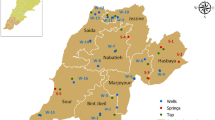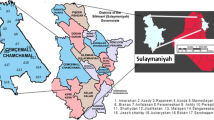Abstract
The purpose of this study was to investigate the radiological quality of drinking water in Ma’an governorate, which includes the archeological city of Petra and is one of Jordan’s most important tourist destinations. To the best of the authors’ knowledge, this is the first study in southern Jordan that investigates radioactivity in drinking water and its potential to cause cancer. A liquid scintillation detector was used to measure gross alpha and gross beta activities in tap water samples from Ma’an governorate. A high-purity Germanium detector was used to measure the activity concentrations of 226Ra and 228Ra. Gross alpha, gross beta, 226Ra, and 228Ra activities were < 110–724 mBq/l, < 220–362 mBq/l, < 11–241 mBq/l, and < 32–49 mBq/l, respectively. The results were compared to internationally recommended levels and literature values. Annual effective doses (\({\mathrm{D}}_{\mathrm{eff}}\)) from 226 and 228Ra intake were calculated for infants, children, and adults. The highest doses were found for children while the lowest were found for infants. For each water sample, the lifetime risk of radiation-induced cancer (LTR) was calculated for the whole population. All of the LTR values were lower than the value recommended by the World Heath Organisation. It is concluded that there are no significant radiation-related health risks associated with consumption of tap water from the studied region.


Similar content being viewed by others
Data availability
The datasets generated during and/or analysed during the current study are available from the corresponding author on reasonable request.
References
Ababsa M (2013) Atlas of Jordan: History, Territories, and Society. Presses de l’Institut Français du Proche-Orient, Beirut
Al Kuisi MM (2015) Hydrogeochemistry of groundwater from karstic limestone aquifer highlighting arsenic contamination: case study from Jordan. Arab J Geosci 8:9699–9720
Alameer S (2011) Natural radioactivity in tap water and associated age-dependent dose and lifetime risk assessment in Amman, Jordan. Appl Radiation Isotopes: including Data, Instrumentation Method Agricul, Industry Med 70(4):692–698. https://doi.org/10.1016/j.apradiso.2011.12.002·Source:PubMed
Alomari AH (2019) Measurement of gross alpha and beta activity concentration in groundwater of Jordan: groundwater quality, annual effective dose and lifetime risk assessment. J Water Health 17:957–970
Al-Shboul K (2017) Radiation hazards and lifetime risk assessment of tap water using liquid scintillation counting and high-resolution gamma spectrometry. J Environ Radioact 178–179:245–252. https://doi.org/10.1016/j.jenvrad.2017.09.005
Beir NR IV (1988) Health Risks of Radon and Other Internally Deposited Alpha-Emitters. National Academies Press USA, Washington (DC)
Beyermann, M. (2009). Strahlenexposition durch natürliche Radionuklide im Trinkwasser in der Bundesrepublik Deutschland. Fachbereich Strahlenschutz und Umwelt. BfS-SW-06/09. Salzgitter, Niedersachsen, Deutschland: Bundesamt für Strahlenschutz (BfS).
Currie LA (1968) Limits for qualitative detection and quantitative determination: application to radiochemistry. Anal Chem 40(3):586–593
Damla N (2006) Gross alpha and beta activities in tap waters in Eastern Black Sea region of Turkey. Chemosphere 62:957–960
Department of Statics. (2020). Retrieved from Estimated Population of the Kingdom by Municipality and Sex , at End-year 2020: http://dosweb.dos.gov.jo/population/population-2/
EPA. (2019). High Resolution Gamma-Ray Spectrometry Analyses for Normal Operations and Radiological Incident Response. Montgomery, AL 36115: National Analytical Radiation Environmental Laboratory Office of Radiation and Indoor Air, U.S. Environmental Protection Agency.
Forte MR (2007) The measurement of radioactivity in Italian drinking waters. Microchem J 85:98–102
IAEA (2004) Quantifying uncertainty in nuclear analytical measurements. International Atomic Energy Agency, Vienna
IAEA. (1999). Assessment Of Doses To The Public From Ingested Radionuclides, Safety Reports Series No. 14. Vienna: International Atomic Energy Agency.
IAEA. ( 2014). Radiation Protection and Safety of Radiation Sources: International BasicSafety Standards, General Safety Requirements Part 3. Vienna: International Atomic Energy Agency.
ICRP. (2007). The 2007 recommendations of the International Commission on Radiological Protection. ICRP Publication 103. Annals of the ICRP, 37(2–4).
ICRP. (2012). Compendium of Dose Coefficients based onICRP Publication 60- ICRP PUBLICATION 119, Ann. ICRP 41. Ottawa, Ontario, Canada: International Commission on Radiological Protection.
Jaber JO (2001) Evaluation of non-conventional water resources supply in Jordan. Desalination 136:83–92
Krishnaswami S (1982) Radium, thorium and radioactive lead isotopes in groundwaters application to the in situ determination of adsorption-desorption rate constants and retardation factors. Water Resour Res 18(6):1633–1675
L’Annunziata MF (2013) Handbook of Radioactivity Analysis. Academic Press, Oceanside, CA- USA.
Mundschenk, H. (1993). Procedure for determining radionuclides in surface water by gamma spectrometry. Federal coordinating office for surface water, suspended particu-late matter and sediment in inland waters, BMU-Germany.
Okunola OJ (2020) Risk assessment of drinkable water sources using gross alpha and beta radioactivity levels and heavy metals. Heliyon 6:e04668
Rice ER (2012) Standard Methods for the Examination of Water and Wastewater, 22nd edn. American Public Health Association, American Water Works Association, Water Environment Federation, Washington, DC
Saleh MA (2015) Natural environmental radioactivity and the corresponding health risk in Johor Bahru district, Johor. Malaysia J Radioanal Nucl Chem 303:1753–2176
Saqan SA (2001) Radionuclides in hot mineral spring waters in Jordan. J Environ Radioact 52:99–107
UNSCEAR (2000) Sources and effects of ionizing radiation, Unscear 2000 report to the general assembly, Annex B. United Nations Scientific Committee On The Effects Of Atomic Radiation, New York
UNSCEAR. (2008). Sources and effects of ionizing radiation, report to the general assembly with scientific annexes, Volume I, Annex B. United Nations, New York: United Nations Scintafic Committee on the Effects of Atomic Radiation.
Vengosh A (2009) High naturally occurring radioactivity in fossil groundwater from the Middle East. Environ Sci Technol 43:1769–1775
WHO (1993) Guidelines for drinking water quality. World Health Organization, Geneva, Switzerland
WHO (2011) Guidelines for drinking-water quality, 4th edn. World Health Organization, Geneva
WHO. (2008). Guidelines for Drinking-water Quality.3rd ed. INCORPORATING THE FIRST AND SECOND ADDENDA Volume 1 Recommendations. Geneva: World Health Organaization.
Acknowledgements
The authors would like to thank the Energy & Minerals Regulatory Commission (EMRC) for measuring and analyzing the samples.
Author information
Authors and Affiliations
Contributions
Dr. AAHQ wrote the main manuscript text, analyzed data, and prepared figures. All authors analyzed data and reviewed the manuscript.
Corresponding author
Ethics declarations
Conflict of interest
The authors declare no competing interests.
Ethical approval
The authors have no conflicts of interest to declare and the research involves no human participants or animals.
Additional information
Publisher's Note
Springer Nature remains neutral with regard to jurisdictional claims in published maps and institutional affiliations.
Rights and permissions
Springer Nature or its licensor (e.g. a society or other partner) holds exclusive rights to this article under a publishing agreement with the author(s) or other rightsholder(s); author self-archiving of the accepted manuscript version of this article is solely governed by the terms of such publishing agreement and applicable law.
About this article
Cite this article
Qwasmeh, A.A.H., Saleh, B.A.A. Radiation dose and lifetime risk for radiation-induced cancer due to natural radioactivity in tap water from Jordan. Radiat Environ Biophys 62, 279–285 (2023). https://doi.org/10.1007/s00411-023-01018-3
Received:
Accepted:
Published:
Issue Date:
DOI: https://doi.org/10.1007/s00411-023-01018-3




